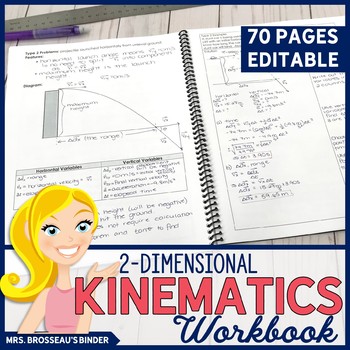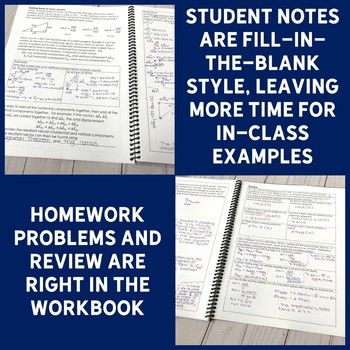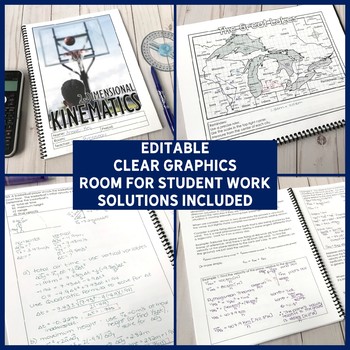2-Dimensional Kinematics Workbook | Physics: 2-D Motion, Projectile Motion
What educators are saying
Also included in
- Are you teaching Physics? Look no further – this growing bundle doesn't stop growing! As an active Physics teacher, I'm always adding new resources and once you've got this bundle you'll be getting all of those updates for free!I’ve bundled my Physics resources with a HUGE DISCOUNT! As I add morePrice $500.00Original Price $692.00Save $192.00
Description
This 2-Dimensional Kinematics Workbook is going to save you and your students so much time in your Physics or Physical Science classes! This EDITABLE*, 70-page workbook covers motion in two dimensions. Students will learn about drawing vectors; adding vectors (using scale diagrams and algebraically); analyzing maps using vectors to scale; projectile motion including finding the components of initial velocity, strategies for three different types of projectile motion problems, solving conditional projectile motion problems, and finding initial velocity of projectiles; acceleration in two-dimensions; and, relative velocity. This workbook has been beautifully formatted in Microsoft Word, with all clear, crisp, custom graphics. Full solutions are included.
A 326-slide PowerPoint is included. There are 13 editable PowerPoint files, and 13 corresponding PDF files (PDF maintains formatting better than Google Slides if PowerPoint is not available). One file includes all 326 slides. The other 12 presentations are the individual sections that correspond to the individual sections of the workbook. The PowerPoint slides cover the lessons, including the examples. Homework problems are not solved in the PowerPoint, but full a full PDF answer key of handwritten solutions is included.
The presentations come in 3 formats:
- editable PowerPoint
- "flattened" PowerPoint which can be uploaded to Google Slides with no change in formatting (OneDrive link included since these are large files)
* Please note, there are only 4 pages that are not editable. Across these 4 pages students practice drawing vectors on a map and working with scale. This can be used as vector practice, homework, or as an assignment. These pages have a map of the Great Lakes area of the USA and Canada that I purchased, and is copyrighted, so these 4 pages only are not editable. The remaining 66 pages are editable in Microsoft Word.
This resource is part of my Growing Physics Bundle. If you like this style of organized note-taking I have other workbooks for Physics units:
1-Dimensional Kinematics workbook
2-Dimensional Kinematics workbook
Forces & Newton's Laws workbook
Momentum & Collisions workbook
Read the topics carefully to see if this workbook is right for you. The PREVIEW shows the watermarked solutions so you can examine if this workbook is right for you.
Students will learn about:
• Drawing vectors in two-dimensions, including different ways of expressing direction.
• Adding vectors, including adding vectors using scale diagrams and adding vectors algebraically. The algebraic addition lesson show examples of adding perpendicular vectors, non-perpendicular vectors, and adding 3 or more vectors using the component method (horizontal and vertical components).
• Analyzing a map’s scale, drawing vectors to scale on a map (I have used this activity as an assignment).
• Projectile Motion, including a thorough analysis of the variables, strategies for and examples of different types of projectile motion problems (level ground, horizontal launch and unlevel ground, angled launch and unlevel ground).
• Conditional Projectile Motion problems, in which students examine problems like “does the tennis ball make it over the net?” and “will the cannonball hit the enemy ship?”
• Finding the initial velocity projectiles. This is a lesson meant to challenge those students who have mastered the previous topics. Strategies for solving for initial speed and launch angle (separately) are explored.
• Acceleration in two dimensions, and,
• Relative velocity (a one-dimensional example is included to scaffold student understanding, but the rest are in two dimensions).
The 2-Dimensional Kinematics Workbook also includes:
• a title page
• an equation page
• a vocabulary page for students to update with key terms throughout the unit
• a preconception page, that asks probing questions at the beginning of the unit and it revisited at the end of the unit.
The zipped folder includes:
• The 70-page 2-Dimensional Kinematics workbook in PDF format and editable Microsoft Word format.
• 326 PowerPoint slides, and PDF slides that cover all of the lessons.
• Complete, handwritten solutions as a PDF file (71 pages).
This workbook is appropriate for AP Physics 1, SPH3U, SPH4U, and similar Physics courses.
How I use the workbooks
I have been using these workbooks with my Physics students for years with great success. Students might be a little intimidated by the thickness of the workbooks at first, but they are VERY grateful when they see that these are mostly fill-in-the-blanks style with room for practice questions. I print them all out at the beginning of the unit and work through them day-by-day on the document camera. I try to get through one lesson per day. However, there are some longer lessons (like projectile motion) that are better split in two or three. I don’t like to instruct all class: I like to take up choice homework questions, infuse experiments into the day, have students work together and review previous concepts. I don’t mark the workbooks, but I do check them for completion. I assign homework from the workbook (which is usually done in class) and some additional homework problems from the textbook.
Let me address some of your questions…
Am I going to be photocopying every day?
Nope! I print off the ENTIRE workbook and give it to the students at the beginning of the unit. You can choose to bind it, staple it, or just hole-punch it for the students’ binders. I find most students like to keep the pages together. Grab a coffee, put your feet up and enjoy the sweet whirl of the photocopier.
Do you hate trees?
I feel very strongly that Physics calculation cannot and should not be done on the computer. By having the workbook printed you are saving your students lots of time and frustration trying to format equations on the computer. When one of your students solves the problem to sustainable energy via nuclear fusion we’ll both agree that this was worth the paper.
You use v1 – I call it vi! What am I to do?
This workbook is editable in Microsoft Word. Yup. That’s how much I love you! If you or your textbook use a different notation, just edit it using the equation. The only things that are not editable are the graphics.
What about our textbooks?
I still use my textbooks for practice problems. Though there are plenty of practice problems in here, you may want to cycle some textbook problems in too. I like to print off one page at the beginning of the unit that has all the homework problems listed by section. By front-loading all the printing and choosing of the homework problems I save a lot of time throughout the unit.
I don’t teach everything that’s included (or I teach it in a different order), so…?
No problem – either delete those pages from the editable file or select only the pages you want while printing. No topics start mid-way through a page so it’s easy to remove something depending on the level of your students. If you teach it in a different order it’s a quick fix on the Print screen. Just type the page numbers in the order you want them, e.g. 1-42, 45, 46, 43, 44, 47-70
I need more Physics resources!
You should check out my Physics Growing Bundle. It’s my priority this year to add to this bundle, and it’s cost increases with each new resource I upload.
Are there labs in here?
No. No labs are included - consider these your students’ notes for the unit. I plan on adding more labs to the Growing Physics Bundle, but most of the labs we do are inquiry-based so there isn’t much need for handouts. My Scientific Method: A Scientific Inquiry Unit would be helpful in this scenario.
I’m a new Physics teacher, will this help me?
Absolutely, yes! I wish I had this when I started teaching Physics 10 years ago! This will save you a ton of time that you can use to grade tests, set-up labs and just keep your head above water.
Can I upload this to Google Classroom/Canvas?
You may upload this to your Learning Management System (Google Classroom, Canvas, Edsby) provided it is password protected and ONLY your students can access the files. File sharing and posting on public websites is strictly prohibited.
If you have any additional questions, feel free to Ask a Question here on TpT, or email me: mrs.brosseau@gmail.com






